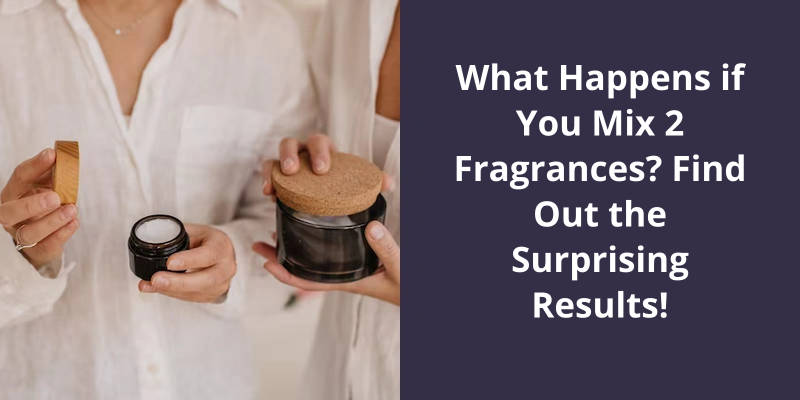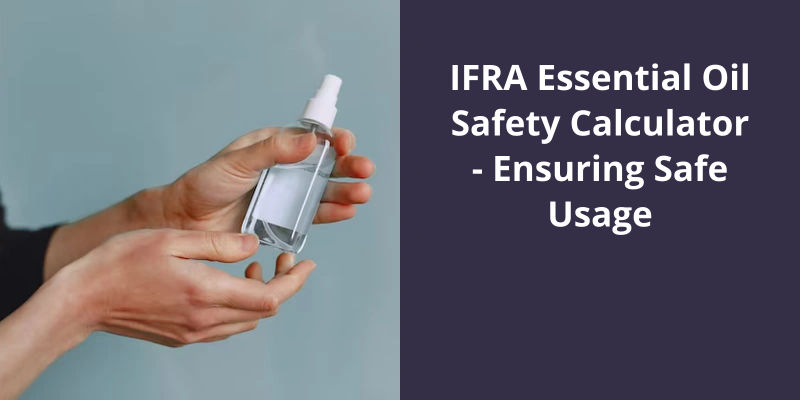Exploring the world of fragrances is a delightful journey that allows us to express our individuality and create unique olfactory experiences. The surprising results that ensue can either be a harmonious symphony or a cacophony of conflicting notes. Mixing fragrances requires careful consideration and an understanding of the fragrance families. One way to ensure a successful fusion is by layering two or more favorite perfumes to create a new, personalized scent. However, the key lies in selecting fragrances within the same family, such as woody, floral, fresh, or citrus, as they’ve a higher chance of blending well with each other. This allows for a refined and sophisticated outcome, while still showcasing one's creativity and individuality. So, whether you aspire to craft a mesmerizing signature scent or simply want to experiment with your fragrance collection, the world of mixing perfumes holds a multitude of exciting surprises!

Can You Use Two Perfumes at Once?
Scent mixing is an age-old practice of wearing various fragrances at once, allowing individuals to express their unique personality and create a distinct scent. While it may sound daunting at first, considering the endless possibilities, experimenting with fragrance combinations can be a delightful experience.
While some perfumes are designed to be worn alone and are complete in themselves, others are meant to be layered with other scents. By layering fragrances, you can create a complex and more personalized aroma. However, it’s crucial to understand the notes and intensity of each perfume to ensure they work well together.
Before experimenting, it’s recommended to test the combination on a small area of your skin to see how the scents interact and evolve throughout the day. This will give you an idea of the longevity and overall effect of the blend. Keep in mind that some perfumes may overpower others, so finding the right balance requires some trial and error.
By combining different perfumes, you can transform a light daytime fragrance into a sensual evening scent or add depth to a citrusy perfume with a touch of warmth. The possibilities are endless, and the surprising results can elevate your fragrance game to another level.
However, it’s important to test the blend on the skin before committing to ensure the two fragrances harmonize well. So go ahead, indulge in the art of scent mixing and discover the surprising results that await you!
Tips for Choosing Complimentary Fragrances to Mix
- Consider scent families: Choose fragrances within the same scent family such as floral, woody, or citrus.
- Test in-store: Take advantage of fragrance testers available in stores to try different combinations on your skin.
- Experiment with top, middle, and base notes: Combine fragrances with different dominant notes to create a well-balanced blend.
- Start with lighter scents: Begin with lighter fragrances and gradually layer stronger scents to avoid overpowering combinations.
- Consider seasonal scents: Choose fragrances that suit the season and transition well between different weather conditions.
- Blend complementary accords: Combine fragrances with complementary accords, such as vanilla and musk or lavender and bergamot.
- Take your time: Allow the fragrances to settle and interact with your body chemistry before finalizing your blend.
- Seek professional advice: Consult fragrance experts or perfumers who can provide personalized recommendations based on your preferences.
When it comes to creating unique and enticing candle scents, the possibilities are endless. One effective and cost-efficient method is to mix different fragrance oils together. By blending two or even three fragrance oils, you can create captivating aromas that cater to your personal preferences. However, it’s crucial to ensure you use the appropriate percentage of fragrance oil based on the type of wax you’re using.
Can I Mix Two Fragrance Oils Together?
Can I mix two fragrance oils together? Yes. However, it’s important to approach fragrance mixing with caution and adhere to certain guidelines to ensure a successful blend. First, consider the types of fragrance oils you’re using. Different fragrance oils have different compositions, which can affect how they blend together. It’s a good idea to choose oils that are complementary or have similar scent families to increase the chances of a harmonious blend.
Next, be aware of the percentage of fragrance oil youre using in relation to the type of wax youre using. Each type of wax has a maximum fragrance load it can hold, and exceeding this limit can result in poor scent throw and even safety hazards. Follow the recommended usage guidelines provided by the fragrance oil manufacturer and perform small test batches before making larger quantities. This will allow you to adjust the ratio of fragrance oils and ensure the final blend is well-balanced and fragrant.
Keep in mind that once youve created a new fragrance blend, it’s a good idea to let it cure for a few days or even weeks to allow the scents to blend and develop. The final scent may differ slightly from the initial blend, so it’s important to be patient and let the fragrance mature.
Mixing fragrance oils together can be a fun way to create unique candle scents. Just remember to choose complementary oils, follow the recommended usage guidelines, and perform small test batches. With a little experimentation and patience, you can discover surprising results and create candles that delight the senses.
How to Store and Label Custom Fragrance Blends
- Choose airtight glass bottles or vials for storing your custom fragrance blends.
- Ensure that the bottles or vials are clean and dry before pouring in the fragrance blend.
- Label each bottle or vial with the name or description of the fragrance blend.
- Use waterproof or oil-resistant labels to prevent smudging or fading.
- Include the date of creation on the label to track the age of the fragrance blend.
- Store the fragrance blends in a cool and dark place, away from direct sunlight or heat.
- Avoid storing the bottles or vials near strong-smelling substances to prevent cross-contamination.
Conclusion
However, caution should be exercised as combining different notes from different fragrances may lead to headaches or overwhelming scents. By experimenting within these guidelines and being mindful of personal preferences, individuals can unleash their creativity and create a personalized scent that’s both enjoyable and alluring.





